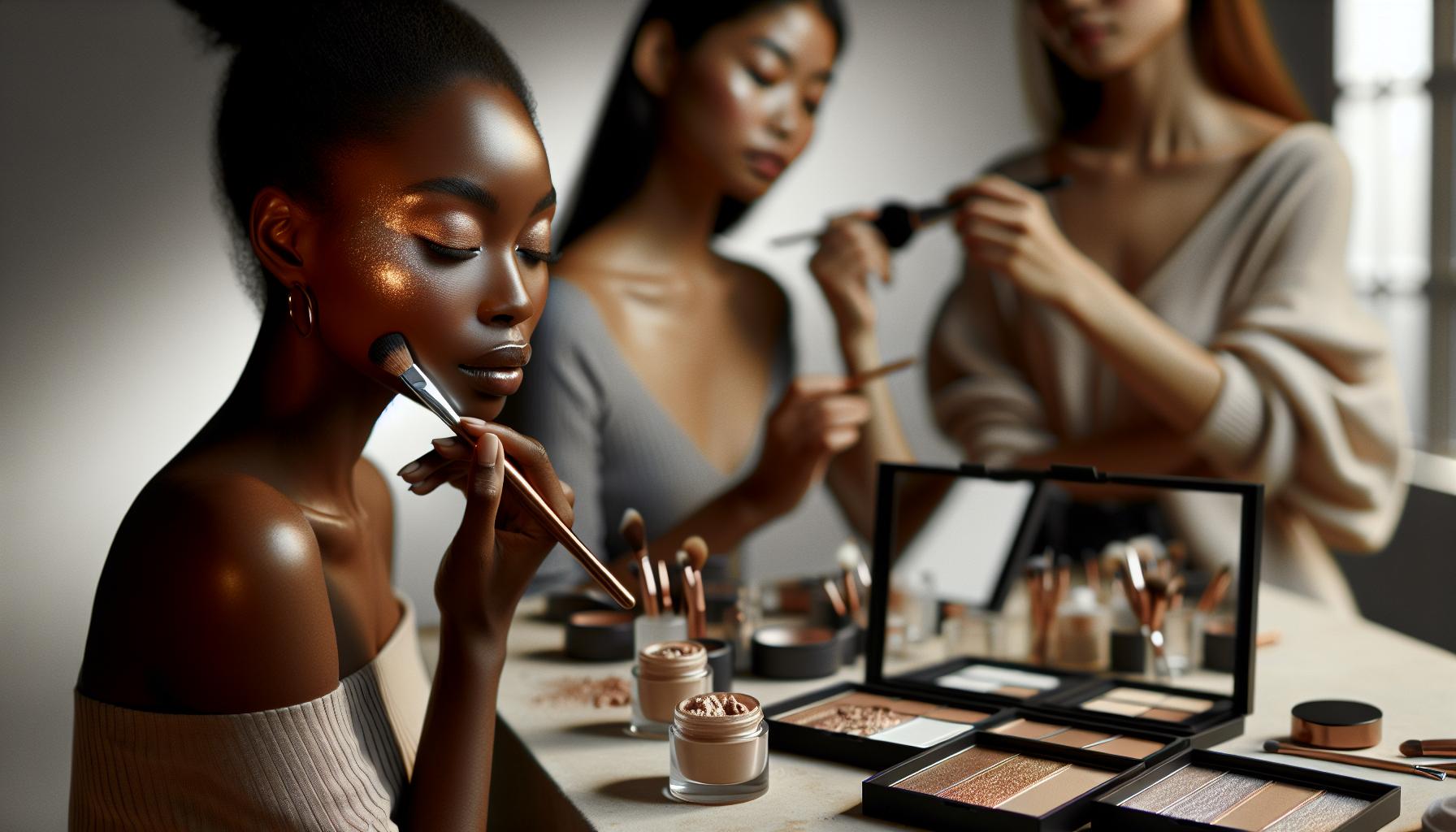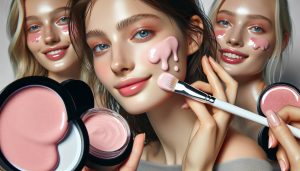Mica has become a popular ingredient in the beauty industry, known for its shimmering effect and versatility in cosmetics. However, many consumers are concerned about the safety of this mineral, particularly with growing awareness of ingredient transparency. Is mica safe for your skin and the environment? As you explore the beauty aisle, it’s crucial to understand how this ingredient can impact not just your makeup routine but also your health and wellness. In this breakdown, we will uncover the truth behind mica, addressing common fears and misconceptions. By the end, you’ll gain the knowledge needed to make informed choices for your beauty regimen, ensuring you can confidently embrace your style while prioritizing safety. Dive in as we demystify mica and its role in makeup!
Understanding Mica: What Is It?
Mica is a naturally occurring mineral that has captivated the beauty industry with its unique properties, primarily its shimmering and reflective qualities. This versatile ingredient can be found in a myriad of makeup products, from eyeshadows to highlighters, providing a pearlescent finish that enhances the overall aesthetic. Composed of a group of silicate minerals, mica is celebrated not only for its light-reflecting ability but also for adding a silky texture, allowing for smooth and blendable application on the skin.
What makes mica particularly interesting is its ability to create a wide range of finishes. Depending on the size of the mica particles and the method of processing, it can produce anything from a soft shimmer to intense sparkle. This adaptability has led to its widespread use in various formulations, including loose powders, creams, and even lip products. Makeup enthusiasts often seek out mica-containing products because they deliver a luminous effect that can complement all skin tones.
Beyond the visual appeal, mica plays a functional role in makeup as well. It assists in oil control and can help products adhere better to the skin, enhancing wear time throughout the day. Additionally, mica is considered a safe ingredient in cosmetics, as it is non-toxic and commonly used, but its safety largely depends on the sourcing and processing methods. Therefore, understanding where and how mica is obtained is crucial, especially as consumers become more aware of ethical considerations tied to beauty products. Exploring the nuances of mica not only sheds light on its role in enhancing beauty but also invites us to consider the larger conversation around ingredient sourcing and safety in the cosmetics industry.
The Role of Mica in Makeup Products

Mica is a star player in the makeup world, renowned for its luxurious shimmer and versatile applications across various cosmetic products. Found in everything from highlighters to eyeshadows, mica serves a dual purpose: it not only enhances visual appeal but also provides functional benefits. When light interacts with mica’s delicate, flat flakes, it creates an iridescent glow that can elevate any makeup look. This unique property has made mica a staple in both traditional cosmetics and innovative beauty formulations.
The magic of mica lies in its ability to vary in particle size and processing method. For instance, finer particles contribute a subtle shimmer ideal for daytime looks, while larger particles can create bold, dramatic effects suitable for evening wear. This adaptability allows formulators to design products tailored to specific needs and preferences, ensuring that there’s a mica-infused product for every makeup enthusiast. In addition to its aesthetic qualities, mica plays a vital role in improving makeup application. It enhances product adherence to the skin and assists in oil control, making it a beneficial ingredient for those with oily or combination skin types.
As consumers become more conscious of ingredient safety and ethical sourcing, understanding mica’s role is more important than ever. Mica’s non-toxic status is a key factor in its popularity; however, ensuring the mica has been ethically sourced is equally critical. Many brands are now committed to transparency in their supply chains, providing consumers with valuable information about the sourcing of their mica. This commitment not only promotes a more ethical cosmetics industry but also empowers consumers to make informed choices that align with their values.
When choosing mica-containing products, consider looking for those issued by brands that prioritize sustainability and ethical practices. Additionally, incorporating these products into your daily routine can empower your self-expression, offering countless opportunities to showcase your personal style. Whether you’re a makeup aficionado or just starting your beauty journey, embracing the enchanting qualities of mica can inspire creativity and confidence in your look.
Is Mica Safe for Skin? An Evidence Review

Mica, a naturally occurring mineral, has gained popularity in the beauty industry not only for its shimmering aesthetics but also for its promising safety profile. This mineral is considered a non-toxic ingredient when used in makeup and skincare products. Research indicates that mica possesses properties that make it well-tolerated by a wide range of skin types. Unlike synthetic additives that may cause irritation, mica generally does not elicit adverse reactions, making it a suitable choice for sensitive skin.
Nevertheless, while mica itself is safe, there are factors to consider regarding its formulation in cosmetics. It’s crucial to distinguish between non-coated and coated mica, as the latter might be treated with chemical substances that could cause sensitivity in some users. When shopping for cosmetic products, looking for those that specify the use of natural mica can help mitigate any potential risks associated with synthetic coatings. To foster a safe beauty routine, consumers should read ingredients thoroughly and opt for products that disclose their sourcing and processing methods.
The application of mica in makeup also extends to functional benefits, such as improving product adherence and providing a smooth application. Consumers are encouraged to conduct patch tests, especially when trying new products for the first time. This simple step can help identify any individual sensitivities before full application, ensuring a positive experience with makeup. Additionally, professional opinions from dermatologists often affirm that makeup products containing mica can enhance overall skin health when used correctly.
In case you have specific concerns or pre-existing conditions affecting your skin, consulting with a dermatologist is always advisable. Education on the safety and sourcing of cosmetic ingredients empowers consumers to make informed choices that align with their values and beauty needs. Whether you’re a makeup novice or an industry pro, being aware of the properties of mica and its role in cosmetics can foster confidence in your beauty regimen.
Potential Health Risks of Mica Exposure
Mica may be celebrated for its versatility and sparkling beauty in cosmetics, but understanding its potential health risks is essential for informed makeup choices. Although mica itself is generally considered safe when used appropriately, exposure can lead to specific health concerns, especially in certain contexts. For example, inhalation of mica dust during manufacturing or application can pose respiratory issues, particularly for individuals with pre-existing lung conditions.
To mitigate these risks, it is crucial for consumers and professionals alike to adopt safe practices. Using products with mica in well-ventilated spaces helps minimize inhalation risks. Additionally, when purchasing loose powders or pigments, consider opting for brands that prioritize safety by ensuring their formulas are free from hazardous dust. Moreover, applying makeup in moderation and avoiding the excessive buildup of products containing mica reduces the likelihood of exposure risks.
Importantly, reactions to mica may vary depending on individual sensitivities. While most people tolerate mica well, some may experience irritation when it is combined with certain chemical additives or in coated forms. Therefore, it’s wise to conduct patch tests on the skin before fully incorporating new products into your routine. This simple practice can help identify potential adverse reactions and foster confidence in your makeup choices.
In summary, while mica remains a valuable ingredient in cosmetics, being mindful of application methods, product types, and individual skin sensitivities can greatly reduce any potential health risks associated with its use. Prioritizing safety not only enhances personal health but also promotes a positive and responsible approach to beauty.
Mica vs. Alternatives: Safety Comparison

When evaluating the safety of lustrous ingredients in cosmetics, mica often stands out for its shimmering qualities, but is it the best choice? Alternative options like synthetic mica and naturally derived minerals are becoming increasingly popular, each presenting distinct safety profiles.
Natural vs. Synthetic Mica
Natural mica is prized for its performance and sparkle, but it can be subject to impurities and environmental concerns linked to mining practices. In contrast, synthetic mica provides the same aesthetic benefits without the ethical implications tied to its extraction. It is manufactured to precise standards, reducing the risks of dust inhalation during application. However, users should note that while synthetic mica may be less likely to irritate sensitive skin, it often lacks the same multi-dimensionality in sparkle that natural mica dominates.
Mineral Alternatives
Among alternatives, minerals like titanium dioxide and zinc oxide also offer exciting benefits. Both are praised for their skin-loving properties, with titanium dioxide acting as a physical blocker in sunscreens and zinc oxide providing anti-inflammatory benefits. While these minerals may not deliver the same reflective qualities as mica, they add value in terms of skin protection and calming irritated skin. Moreover, they are less likely to cause respiratory issues, making them viable options for those concerned about inhalation.
In the comparative safety landscape, the choice between mica and its alternatives ultimately hinges on personal preferences and specific skin needs. Professionals and consumers alike should consider ingredient sourcing, personal sensitivities, and desired product performance when making selections. The landscape of makeup products continues to evolve, offering beauty enthusiasts a variety of options to explore-ensuring a mindful approach to beauty that aligns with individual values and health priorities.
Label Reading: Identifying Mica in Makeup
When navigating the cosmetic aisle, the myriad of ingredient labels can often feel daunting, especially when it comes to identifying mica. This fascinating mineral is not only what gives products their alluring shimmer but also speaks to the quality of the makeup itself. Most commonly found in items such as eyeshadows, highlighters, and illuminators, mica can be listed under various names, requiring a discerning eye and a bit of knowledge to spot it effectively.
To streamline your label-reading experience, look for these common names associated with mica: Mica, Synthetic Mica, CI 77019 (which refers to a natural form of mica colored with titanium dioxide), or CI 77018 (iron oxide-coated mica). Ingredients may also be combined with other descriptors, such as “Mica (and) Titanium Dioxide”, highlighting the mineral’s use alongside other elements to enhance product performance and opacity. Understanding these distinctions can lead you to more informed choices about what goes on your skin.
Understanding Mica’s Role
It’s essential to recognize that the context in which mica is used can impact its safety and performance. Mica often serves not just for aesthetic shimmer but also helps provide a smooth application and can improve the longevity of makeup wear. Consider, for instance, products from reputable brands like Seint or Thrive that clearly detail their mica sourcing and formulation practices. Transparency in ingredient sourcing can give you added confidence in your choices.
Actionable Tips for Consumers
- Scour the Labels: When selecting makeup, take the extra few moments to read ingredient lists rather than solely relying on marketing slogans.
- Research Brands: Dive into reputable brands’ commitment to ethical sourcing. Brands that prioritize sustainability often disclose their ingredient sourcing practices more openly.
- Patch Test New Products: If you are trying a mica-based product for the first time, perform a patch test to gauge any potential sensitivity or adverse reactions, particularly if you have sensitive skin.
Being knowledgeable about ingredients such as mica not only enhances your makeup selection process but also empowers you as a consumer. Each time you read an ingredient label, you’re taking an active role in ensuring that the products you choose align with your personal standards for safety, ethics, and performance in beauty.
Ethical Concerns Surrounding Mica Sourcing
The beauty industry thrives on the magical allure of shimmering eyeshadows and lustrous highlighters, yet beneath the surface, an intricate web of ethical concerns surrounds mica sourcing. Mica, a mineral that adds sparkle and depth to makeup, is predominantly mined in countries with lax labor regulations, leading to troubling practices such as child labor and unsafe working conditions. As consumers become increasingly aware and concerned about the origins of their beauty products, the demand for ethically sourced mica is rising, prompting brands to reevaluate their supply chains.
One of the major ethical dilemmas stems from the mining practices prevalent in regions like India, where much of the world’s mica is sourced. Reportedly, an estimated 20% to 30% of mica is produced through illegal mining, often conducted in hazardous environments. This mining not only endangers the workers involved but also poses risks to the surrounding ecosystems. Brands that prioritize ethical sourcing must ensure transparency in their supply chains and actively support initiatives that promote safe and fair working conditions. This transparency not only aligns with ethical consumerism but also builds brand loyalty among customers who seek socially responsible options.
To align personal values with purchasing decisions, consumers can take actionable steps such as researching brands committed to ethical mica sourcing. Many companies are beginning to share detailed information about their supply chains and sustainability efforts. For those consumers seeking to make responsible choices, understanding which brands prioritize fair labor practices and environmental sustainability can guide better purchasing decisions. Moreover, supporting organizations and initiatives that work towards improving the mining conditions can foster positive change within the industry.
As the conversation surrounding ethical sourcing grows, it’s imperative for both brands and consumers to engage actively. This collective awareness can drive a shift towards safer, fairer practices in mica sourcing, ensuring that the products we use not only enhance our beauty but also uphold our ethical standards. Investing time in understanding the sources of our makeup is not just about individual wellness but also about contributing to the broader mission of justice and sustainability in the beauty industry.
Mica Regulation: What You Need to Know
Navigating the world of cosmetic ingredients can feel overwhelming, especially when it comes to understanding regulatory frameworks surrounding materials like mica. Unlike other ingredients, mica does not have strict global regulations specifically governing its use in cosmetics, which presents a unique challenge for consumers and manufacturers alike. This lack of targeted legislation means that while mica is generally recognized as safe for cosmetic use, the methods of its extraction and the labor practices involved in its supply chain are less regulated, raising significant ethical issues.
To ensure that the mica used in makeup is safe and ethically sourced, consumers should look for brands that adhere to responsible sourcing guidelines. Many reputable companies are now becoming transparent about their supply chains, collaborating with established organizations dedicated to improving mining conditions. For instance, brands that participate in initiatives such as the Responsible Mica Initiative commit to eliminating child labor and ensuring fair treatment of workers, thus providing a safer and more ethical product for consumers.
In navigating mica safety, consumers can adopt practical steps to support responsible practices in the beauty industry. Reading labels is essential; look for certifications or statements that indicate ethical sourcing practices. Furthermore, consider reaching out to brands directly to inquire about their mica sourcing policies. Engaging in such conversations not only fosters brand accountability but also reinforces consumer demand for ethically sourced products.
The ongoing dialogue about mica regulation highlights the growing awareness and accountability expected from beauty brands. As consumers become more educated about the origins and implications of the ingredients in their products, industry standards are likely to evolve, prompting more comprehensive regulations. By prioritizing brands that prioritize ethical sourcing and transparency, consumers can help pave the way for a safer and more humane cosmetic industry.
Expert Opinions on Mica Safety
Mica is a mineral that has captivated the beauty industry for its shimmering qualities and versatility, but questions about its safety persist. Experts in dermatology and cosmetic chemistry often stress that while mica itself is generally regarded as safe for topical application, the context of its use matters significantly. Concerns often arise regarding contamination or impurities during mining, which can impact the end product. Thus, reputable brands prioritize rigorous testing to ensure their mica is free from harmful elements.
According to dermatologists, when incorporated into cosmetics, mica functions primarily as a shimmer agent, enhancing the aesthetic appeal of products like powders, eyeshadows, and highlighters. It achieves this lustrous finish without altering the skin’s barrier, making it suitable for most skin types. However, individuals with extremely sensitive skin or those who may react negatively to any particulate matter should conduct patch tests prior to broader application. Experts advocate checking for added ingredients that could cause irritation along with mica, reinforcing the need for comprehensive ingredient scrutiny.
The conversation around mica is evolving, especially regarding ethical sourcing and sustainability in the beauty sector. Leading industry voices emphasize the importance of transparency; they encourage consumers to support brands that provide clear information about their mica sourcing practices. Brands that are involved in responsible sourcing initiatives work to guarantee not only the safety of the ingredient but also the ethical conditions under which it is mined. Such practices not only enhance consumer confidence but contribute positively to global mining standards.
In summary, expert opinions converge on a key point: while mica is safe for use in cosmetics, awareness around sourcing and potential sensitivities is essential. Consumers are empowered by knowledge, enabling them to make informed decisions that align with their values-whether they prioritize ingredient safety, ethical practices, or environmental considerations. As the beauty industry continues to address these issues, the role of informed consumers will be pivotal in shaping a more responsible and safe cosmetics landscape.
Consumer Awareness: Making Informed Choices
In today’s beauty landscape, making informed choices about the products we use on our skin has never been more essential. Mica, a popular mineral used for its shimmering properties, often finds itself at the center of discussions surrounding safety and ethical sourcing. As consumers become more conscious of ingredient origins and their potential impacts, understanding how to navigate these waters is key.
When selecting makeup products that contain mica, it’s vital to pay attention to the brand’s sourcing practices. High-quality brands that prioritize ethical sourcing often provide clear information on how their mica is mined and processed. Look for companies that are transparent about their supply chains, as this is indicative of a brand that values not only the safety of its products but also the ethical treatment of labor involved in extraction. Supporting such brands can drive positive change in the industry, encouraging more companies to adopt sustainable practices.
Conducting thorough research is another essential component of making informed choices. Before purchasing, consult product labels and ingredient lists. Mica is often listed under various names, such as “mica powder” or “natural mica,” so familiarity with these terms will help you identify its presence. Additionally, be aware of potential allergenic ingredients that may accompany mica in formulations. Brands that offer options free from artificial colors and fragrances are particularly appealing to those with sensitive skin, providing an extra layer of safety.
Simply knowing your ingredients is not enough; understanding your skin’s unique needs is equally important. For individuals with sensitive skin, performing patch tests before fully applying a new product can help identify potential reactions. Aligning product choices with personal skin sensitivities and ethical values not only enhances your beauty regimen but also empowers you to be a conscientious consumer in a crowded marketplace. Remember, every informed choice contributes to fostering a beauty industry that prioritizes safety and ethics, paving the way for a brighter, more responsible future in cosmetics.
Navigating Mica Safety for Sensitive Skin
Navigating the world of makeup can be overwhelming, especially for those with sensitive skin. Mica, a commonly used ingredient known for its shimmering properties, can sometimes pose challenges for sensitive individuals. Understanding how to choose mica-containing products wisely is crucial to maintaining skin health while enjoying the vibrant and diverse offerings of the beauty industry.
To ensure safety, always perform a patch test when trying a new product, particularly those containing mica. Apply a small amount on a discreet area of skin, such as the inside of the wrist or behind the ear, and wait 24 hours to observe any reactions. This simple step can help you gauge your skin’s tolerance, minimizing the risk of a full-blown allergic reaction when applying makeup to delicate areas like the face.
Choosing the right products is also vital. When examining ingredient lists, look for brands that offer formulations specifically designed for sensitive skin. Such products often exclude common irritants like synthetic dyes, fragrances, and parabens, creating a more skin-friendly environment. Natural and cruelty-free brands often provide greater transparency, allowing consumers to better understand where their mica comes from and how it’s processed. Look for labels that specify “sensitive skin tested” or “hypoallergenic” to guide your selection process.
In addition to ingredient scrutiny, it’s beneficial to stay informed about the potential effects of regular makeup use on sensitive skin. Some individuals may find that products with milled or finer mica can be less irritating than those with larger particles, providing a softer application without compromising the lustrous finish. Always seek out formulations that combine mica with skin-nourishing ingredients like natural oils or hydrating agents to enhance overall skin health while allowing you to shine.
Empowering yourself with knowledge about mica and its implications for sensitive skin can lead to a more enjoyable makeup experience. Balance your aesthetic needs with skin safety, and you’ll cultivate a beauty regimen that both enhances your look and protects your skin, enabling you to express your unique style confidently.
Future of Mica in the Beauty Industry
The landscape of the beauty industry is on the cusp of transformation, particularly regarding the use of mica, a mineral prized for its shimmering qualities. With an increasing spotlight on sustainability and ethical sourcing, future developments are expected to align closely with consumer demands for transparency and responsible practices. This shift presents both challenges and opportunities for brands, as they navigate a market increasingly driven by consumer awareness of ingredient safety and sourcing ethics.
As consumers grow more mindful about what goes into their beauty products, brands will need to innovate not only in formulation but also in sourcing practices. This might mean adopting rigorous traceability protocols to ensure that mica is sourced ethically from mines that prioritize workers’ rights and environmental sustainability. Companies committed to these practices can strengthen their brand image while simultaneously addressing consumer concerns about labor conditions often associated with mica mining.
Moreover, the beauty industry may witness a rise in alternatives to natural mica, including synthetic options that mimic its aesthetic properties without the ethical dilemmas. As these alternatives evolve, they could provide a safer choice for sensitive skin, as they can be designed to be free from contaminants often found in mined mica. Such developments can enhance product safety while satisfying the appetites of well-informed consumers seeking cutting-edge beauty solutions.
Ultimately, the hinges on a balance between maintaining the beloved qualities it brings to makeup products and the growing necessity for ethical considerations. By embracing this challenge, brands not only enhance their product offerings but also contribute positively to the broader dialogue about sustainability and safety in beauty, paving the way for more conscientious consumer choices.
Faq
Q: What is mica used for in makeup products?
A: Mica is primarily used in makeup products for its shimmering and reflective properties, enhancing the color and texture of cosmetics. It provides a natural glow and can help create luminosity in products like highlighters, eyeshadows, and foundation.
Q: Is all mica safe for skin application?
A: While most cosmetic-grade mica is considered safe for skin application, it’s crucial to use products from reputable brands that comply with safety regulations. Always refer to the specific safety review in our article, “Is Mica Safe for Skin? An Evidence Review,” for detailed insights.
Q: Are there alternatives to mica in cosmetics?
A: Yes, alternatives to mica include synthetic mica, rice powder, and certain minerals like titanium dioxide. These substitutes can provide similar effects without the ethical concerns associated with natural mica sourcing. Check our section on “Mica vs. Alternatives: Safety Comparison” for a deeper look.
Q: How can I identify mica in makeup products?
A: To identify mica in makeup, read the ingredient list on the product label. Mica may be listed simply as “mica” or “CI 77019.” Understanding how to read labels is crucial; refer to our section on “Label Reading: Identifying Mica in Makeup” for more details.
Q: What are the ethical concerns surrounding mica sourcing?
A: Ethical concerns regarding mica sourcing mainly involve child labor and poor working conditions in mining regions. Raising awareness of these issues can empower consumers to choose ethically sourced products, as discussed in our section on “Ethical Concerns Surrounding Mica Sourcing.”
Q: Is mica safe for sensitive skin?
A: Mica is generally safe for sensitive skin, but individual reactions can vary. It’s best to conduct a patch test when trying new products. For tips on navigating makeup safety for sensitive skin, see “Navigating Mica Safety for Sensitive Skin” in our article.
Q: What regulations affect mica in cosmetics?
A: Mica in cosmetics is regulated under various safety and labeling laws, but specific regulations can vary by country. Ensure that you are informed about your region’s regulations by referring to our section on “Mica Regulation: What You Need to Know.”
Q: How do expert opinions influence the perception of mica safety?
A: Expert opinions can shape consumer trust in mica safety through research and advocacy. Consulting the insights in our section “Expert Opinions on Mica Safety” can provide a balanced view based on scientific evidence and ethical considerations.
Insights and Conclusions
Understanding the safety of mica in makeup is crucial for making informed beauty choices. While we’ve dissected the myths and facts, you’re now equipped to choose products wisely. If you’re concerned about ingredient safety, explore our detailed reviews on brands like Seint, Thrive, and Ilia, or dive into our step-by-step makeup tutorials to enhance your skills further. Don’t miss out on our recommendations for cleansing routines and professional barbering techniques that complement your beauty journey.
Ready to elevate your makeup game? Subscribe to our newsletter for the latest updates and expert tips that keep you in the know. Whether you’re a makeup enthusiast or a seasoned pro, we invite you to explore related content that sparks your creativity and supports your personal style development. Share your thoughts or questions in the comments below, and let’s foster a community where beauty and grooming excellence thrive together!










